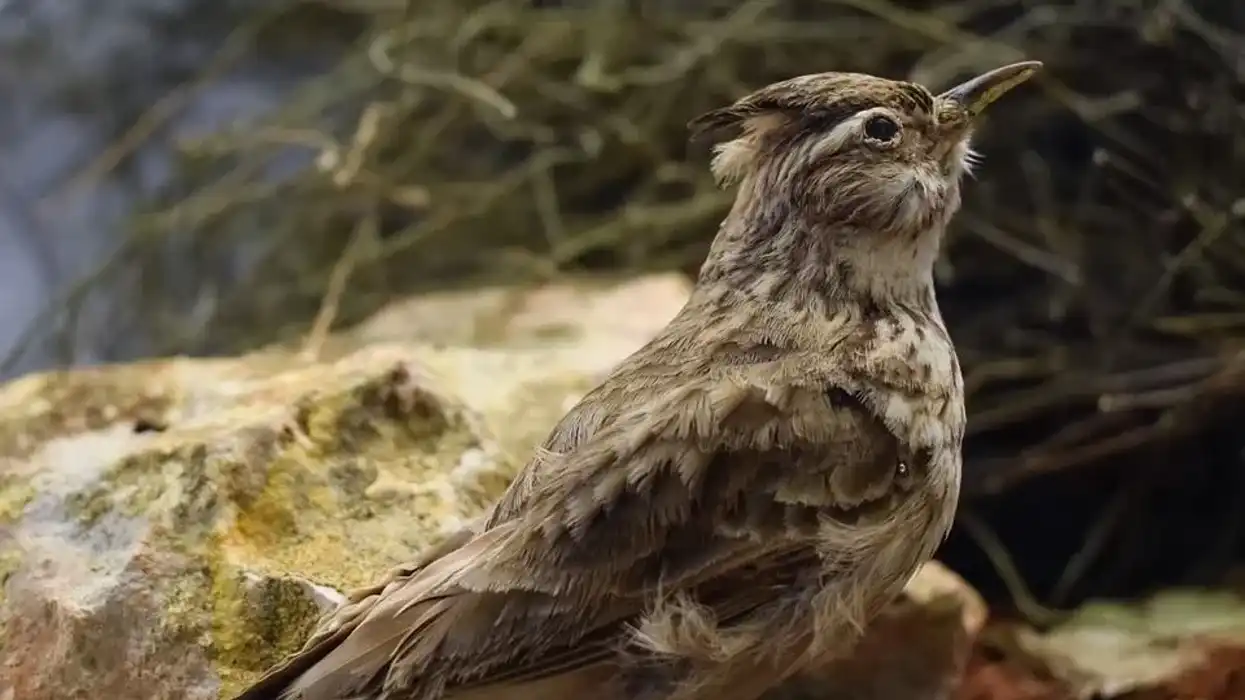Eurasian skylark (Alauda arvensis) is a bird species that is found in many places around the world. Its range extends from North America and Europe to Asia, which is why most people are aware of the beautiful song of this species.
These birds are characterized by their brown-black color, small size, and great flying skills. While they are not endemic to any place on Earth, they are considered to be native to Eurasia, hence the name.
One interesting fact about Eurasian skylarks is that its population in the north Europe does not migrate, but the population towards the south of Europe does.
Eurasian Skylark Interesting Facts
What type of animal is a Eurasian skylark?
Eurasian skylark (Alauda arvensis) is a type of bird which is very common in Europe and Asia. This bird was introduced in several parts of the world but is native to the Palearctic. Birds of this species are found in several places in North America and New Zealand, and isolated groups show migratory habits.
What class of animal does a Eurasian skylark belong to?
Scientifically, Eurasian skylarks are classified as Aves. However, we can commonly classify them to be birds.
How many Eurasian skylarks are there in the world?
Since the Eurasian skylark distribution is so widespread, there are no conclusive studies that can tell us about the global population of these birds. However, the conservation status of the species suggests that their population strength is quite high and fairly stable as well.
Where does a Eurasian skylark live?
In the natural world, Eurasian skylarks are found in meadows, marshes, and croplands. Such habitat ensures that these birds have the correct environment to build a nest, make a family, and also feed on their favorite foods.
What is a Eurasian skylark's habitat?
A Eurasian skylark range of habitat is quite extensive. It is found in nearly all parts of the world. However, they sometimes move with a season change.
They are known to be resident birds. Such birds would be the ones that live in the southern parts of Eurasia. The ones that live in the north of Eurasia are migratory in nature.
These birds can be spotted in Australia, New Zealand, North America, and the Hawaiian islands, in addition to the Palearctic, the native place of this species.
Who do Eurasian skylarks live with?
Eurasian skylarks exhibit a range of social behavior patterns. When the weather becomes too harsh, birds of this species tend to make flocks so as to combat the conditions together.
Some large flocks may contain as many as 10 Eurasian skylarks. However, it is more common for birds to form smaller flocks. Even if some birds make a flock that has more than 10 birds, it is likely to divide.
On the other hand, these birds of the lark family are very territorial and aggressive around the breeding season, which is in the summer months. In the breeding season, these birds protect their nests and feeding areas, and signs of aggression would include aerial shows and gliding movements. The behavior of these birds is largely dependent on the weather.
How long does a Eurasian skylark live?
The average Eurasian skylark life expectancy is of a little more than 10 years. This is considered a great lifespan for any member of the lark family.
How do they reproduce?
Eurasian skylark (Alauda arvensis) is an oviparous bird species. This means that the female skylarks of this species lay eggs instead of giving birth to nestlings.
Female bird builds a nest on a depression in the ground and lines it with grass so as to provide a base for the eggs to rest in. A clutch consists of around three to five eggs. It is also important to note that Eurasian skylark parents can only reproduce once in a year.
The breeding season starts in April and goes on till July. Once the eggs are laid, female birds take care of them. The eggs hatch in about 11-15 days, after which both parents feed the nestling. Nestlings become ready to leave their nest in around 10 days, after which, they slowly become independent.
What is their conservation status?
IUCN (International Union for Conservation of Nature) Red List states that the conservation status of Eurasian skylark (Alauda arvensis) species is that of Least Concern. This means that these birds from North America, New Zealand, and Eurasia have a very stable population. They are unlikely to face any serious threats of extinction for decades to come.
Eurasian Skylark Fun Facts
What do Eurasian skylarks look like?
This member of the lark family shows a rather small set of colors when it comes to plumage. A Eurasian skylark size is best classified as small and these birds are characterized by their dull-colored feathers.
Throughout most of their bodies, these skylarks are brown-black or gray in color. Some parts of the body, such as the breasts, can be buff-white in color, which creates a great contrast.
These birds have crests on their heads, which can be raised or brought lower as required. This is a rather fascinating ability that these beautiful birds have. Additionally, the brown-colored feathers on their bodies are also lined with white color, which provides a stunning look.
Males and females of this species do not show much sexual dimorphism except for the fact that male Eurasian skylarks have wider wings than their female counterparts. Their bills are buffy white or brown-ish in color, and their tails are small in length.

How cute are they?
Eurasian skylarks are a very beautiful bird species. These birds have the most amazing plumage, which hardly fails to stun us in spite of their dull colors. In addition to this, these skylarks also look quite spectacular in flight, especially when gliding top high elevations to guard their territories.
How do they communicate?
Like other birds, Eurasian skylarks also communicate through vocalizations. Eurasian skylark's call is melodic and repetitive. The songs go on for a shorter duration in the winter season, but in the breeding season, Eurasian skylark's song becomes a way for males to attract females.
Male birds usually sing when in flight. They circle and hover over areas whilst singing a melody that lasts typically for two or three minutes. In the range of their habitat, the song of male Eurasian skylarks is pretty well known, and they uphold the impression that we have about the lark family in terms of singing skills.
How big is a Eurasian skylark?
Eurasian skylark is a rather small bird. Its average length remains in the range of 7.1-7.5 in (18-19 cm). These birds don't have a long tail either.
How fast can a Eurasian skylark fly?
Unfortunately, there are no records or studies which can tell us about the speed at which birds of this species can fly. However, given the small size and lightweight that these birds are known by, we can assume that they are great at flying around.
How much does a Eurasian skylark weigh?
The average weight of a bird of the Eurasian skylark species is 0.6-1.9 oz (17-55 g). Understandably, these birds are quite light-weighted.
What are the male and female names of the species?
There are no special names for the male and female Eurasian skylarks. Hence, we lovingly refer to them as the male Eurasian skylarks and female Eurasian skylarks.
What would you call a baby Eurasian skylark?
A baby Eurasian skylark, like all other baby birds, would be called a nestling. This name is only applicable until juveniles are capable of flight.
What do they eat?
Eurasian skylarks' diet consists of insects and seeds. Throughout their range of habitat, birds of this species forage on the ground for any insects or seeds that they might find. Parents also find seeds to feed their nestlings till they can fledge.
Are they dangerous?
Even during the breeding season, when male Eurasian skylarks are at their most aggressive state, these birds do not pose any threats to humans or any other animals. It is thus best to give these birds some seeds to eat and enjoy their beautiful song.
Would they make a good pet?
In North America, Europe, and Asia, it is not very common to have a Eurasian skylark as a pet. However, taking care of these birds is fairly simple. Unless there are too many other birds in the same cage, you can consider having a Eurasian skylark as a pet.
Did you know...
Eurasian skylark would build its nest on the ground. Juveniles remain in the nest for around 10 days.
Males are famous for their sweet-sounding songs. A song would typically go on for a longer duration in the breeding season.
Eurasian skylarks have a stable global population.
Are Eurasian skylarks an endemic species?
Eurasian skylarks are not endemic to any place in the world.
What does a skylark symbolize?
The song of a skylark is typically most loud and lengthy in spring and summer months, which shows the onset of a new phase.










